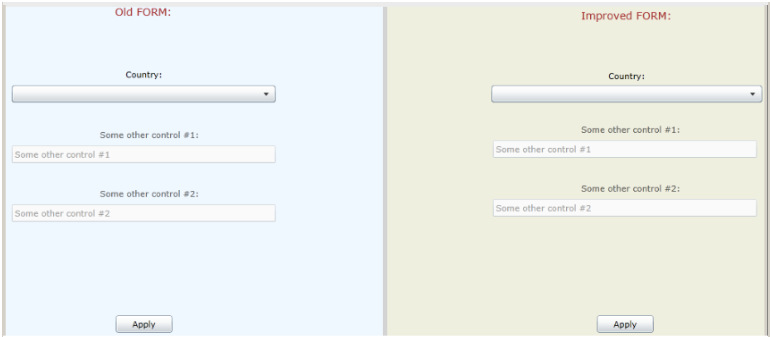Introduction
In this tip, I show usage of a usability technique that can be called “Combobox with Most Recently Used sub-list”. Such a technique is, partially, used in Microsoft Word for a long time – see this link.
Here I show why and how I used it in a real desktop product I developed some time ago.
An Original GUI
Unfortunately, I cannot give the exact screenshots of the application I worked on (it belongs to my Customer). So I show usage of the technique in a simplified Microsoft Silverlight demo here.
In the Silverlight application, we see the following screen:

The left part of the screen is a prototype of a Form of my application. This is an 'original' version - i.e. before I used this technique:
In this tip, we consider only the Country control that contains names of all the EU countries (27 names). They are alphabetically ordered:
A user of this Form typically fills out this (and other) fields; and then clicks the Apply button. The specified data will be put into the application’s database, and then the Form fields will be cleared. This is quite a typical GUI scenario.
An Improvement of the Original GUI
After the first version of the Form had been used by real Users for some time, I saw the following:
Though EU has 27 countries, Users had mostly selected 3 of them – United Kingdom, Germany and France. Those 3 countries gave ~85% of all the Counties entered by the Users. The fact is caused by the specifics of the Application and the data it processes
So I thought – was this possible to accelerate work of a typical User (the Form was called quite often in a typical scenario) using that fact? I applied the technique "Combo with Most Recently Used Items sub-list" I had seen in Microsoft Word. Look at the right part of the screen here - it shows an improved version of the original Form.
Below is what a User will see in the drop-down list of the Combobox:
As you see, the Most Recently Used sub-list at the top of the drop-down Combobox list contains the 3 countries originally – United Kingdom, Germany and France.
But content of the Most Recently Used sub-list is not static. After a User clicks the Apply button, a selected country will be put into the beginning of the Most Recently Used sub-list. Its other items will be scrolled down. For example, below is what happens if we select Austria and click Apply:

The largest possible size of the Most Recently Used sub-list is 5 countries. The count and order of the items in the other sub-list (All Countries) do not change as the Most Recently Used sub-list changes.
